Honda CR-V: DTC P0122: TP Sensor A Circuit Low Voltage
NOTE: Before you troubleshoot, record all freeze data and any on-board snapshot, and review the general troubleshooting information.
1. Turn the ignition switch ON (II).
2. Clear the DTC with the HDS.
3. Check TP SENSOR A in the DATA LIST with the HDS.
Is there about 0.3 V or less? YES-Go to step 4.
NO-Intermittent failure, the system is OK at this time. Check for poor connections or loose terminals at the throttle body and the PCM.
4. Check for Temporary DTCs or DTCs with the HDS.
Are DTC PO 122 and P0222 indicated at the same time? YES-Go to step 10.
NO-Go to step 5.
5. Turn the ignition switch OFF.
6. Disconnect the throttle body 6P connector.
7. Jump the SCS line with the HDS.
8. Disconnect PCM connector C (44P).
9. Check for continuity between throttle body 6P connector terminal No.1 and body ground.
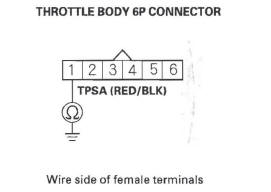
Is there continuity? YES-Repair short in the wire between the throttle body and the PCM (C20), then go to step 18.
NO-Go to step 23.
10. Measure voltage between throttle body 6P connector terminal No. 2 and body ground.
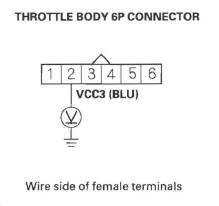
Is there about 5 V? YES-Go to step 16.
NO-Go to step 11.
11. Turn the ignition switch OFF.
12. Jump the SCS line with the HDS.
13. Disconnect PCM connector C (44P).
14. Disconnect the throttle body 6P connector.
15. Check for continuity between PCM connector terminal C12 and throttle body 6P connector terminal No. 2.
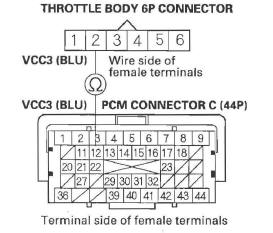
Is there continuity? YES-Go to step 23.
NO-Repair open in the wire between the throttle body and the PCM (C12), then go to step 18.
16. Turn the ignition switch OFF.
17. Replace the throttle body.
18. Reconnect all connectors.
19. Turn the ignition switch ON (II).
20. Reset the PCM with the HDS.
21. Do the PCM idle learn procedure.
22. Check ,for Temporary DTCs or DTCs with the HDS.
Is DTC P0122 indicated? YES-Check for poor connections or loose terminals at the throttle body and the PCM, then go to step 1.
NO-Troubleshooting is complete. If any other Temporary DTCs or DTCs are indicated, go to the indicated DTC's troubleshooting.
23. Reconnect all connectors.
24. Update the PCM if it does not have the latest software, or substitute a known-good PCM.
25. Check for Temporary DTCs or DTCs with the HDS.
Is DTC P0122 indicated? YES-Check for poor connections or loose terminals at the throttle body and the PCM. If the PCM was updated, substitute a known-good PCM, then recheck. If the PCM was substituted, go to step 1.
NO-If the PCM was updated, troubleshooting is complete. If the PCM was substituted, replace the original PCM. If any other Temporary DTCs or DTCs are indicated, go to the indicated DTC's troubleshooting.
DTC P0123: TP Sensor A Circuit High Voltage
NOTE: Before you troubleshoot, record all freeze data and any on-board snapshot, and review the general troubleshooting information.
1. Turn the ignition switch ON (II).
2. Clear the DTC with the HDS.
3. Check TP SENSOR A in the DATA LIST with the HDS.
Is there about 4.8 V or more? YES-Go to step 4.
NO-Intermittent failure, the system is OK at this time. Check for poor connections or loose terminals at the throttle body and the PCM.
4. Check for Temporary DTCs or DTCs with the HDS.
Are DTC P0123 and P0223 indicated at the same time? YES-Go to step 13.
NO-Go to step 5.
5. Turn the ignition switch OFF.
6. Disconnect the throttle body 6P connector.
7. Turn the ignition switch ON (II).
8. Measure voltage between throttle body 6P connector terminal No.1 and body ground.
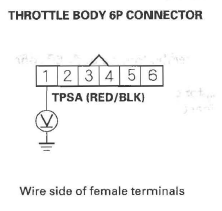
Is there about 5 V? YES-Go to step 18.
NO-Go to step 9.
9. Turn the ignition switch OFF.
10. Jump the SCS line with the HDS.
11. Disconnect PCM connector C (44P).
12. Check for continuity between PCM connector terminal C20 and throttle body 6P connector terminal No.1.
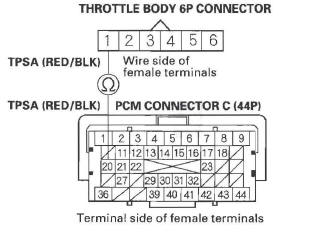
Is there continuity? YES-Go to step 25.
NO-Repair open in the wire between the throttle body and the PCM (C20), then go to step 20.
13. Turn the ignition switch OFF.
14. Disconnect the throttle body 6P connector.
15. Jump the SCS line with the HDS.
16. Disconnect PCM connector C (44P).
17. Check for continuity between PCM connector terminal C39 and throttle body 6P connector terminal No. 4.
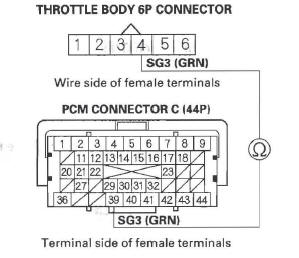
Is there continuity? YES-Go to step 25.
NO-Repair open in the wire between the throttle body and the PCM (C39), then go to step 20.
18. Turn the ignition switch OFF.
19. Replace the throttle body.
20. Reconnect all connectors.
21. Turn the ignition switch ON (II).
22. Reset the PCM with the HDS.
23. Do the PCM idle learn procedure.
24. Check for Temporary DTCs or DTCs with the HDS.
Is DTC P0123 indicated? YES-Check for poor connections or loose terminals at the throttle body and the PCM, then go to step 1.
NO-Troubleshooting is complete. If any other Temporary DTCs or DTCs are indicated, go to the indicated DTC's troubleshooting.
25. Reconnect all connectors.
26. Update the PCM if it does not have the latest software, or substitute a known-good PCM.
27. Check for Temporary DTCs or DTCs with the HDS.
Is DTC P0123 indicated? YES-Check for poor connections or loose terminals at the throttle body and the PCM. If the PCM was updated, substitute a known-good PCM, then recheck. If the PCM was substituted, go to step 1.
NO-If the PCM was updated, troubleshooting is complete. If the PCM was substituted, replace the original PCM. If any other Temporary DTCs or DTCs are indicated, go to the indicated DTC's troubleshooting.
DTC P0222: TP Sensor B Circuit Low Voltage
NOTE: Before you troubleshoot, record all freeze data and any on-board snapshot, and review the general troubleshooting information.
1. Turn the ignition switch ON (II).
2. Clear the DTC with the HDS.
3. Check TP SENSOR B in the DATA LIST with the HDS.
Is there about 0.3 V or less? YES-Go to step 4.
NO-Intermittent failure, the system is OK at this time. Check for poor connections or loose terminals at the throttle body and the PCM.
4. Check for Temporary DTCs or DTCs with the HDS.
Are DTC P0122 and P0222 indicated at the same time? YES-Go to step 10.
NO-Go to step 5.
5. Turn the ignition switch OFF.
6. Disconnect the throttle body 6P connector.
7. Jump the SCS line with the HDS.
8. Disconnect PCM connector C (44P).
9. Check for continuity between throttle body 6P connector terminal No.3 and body ground.
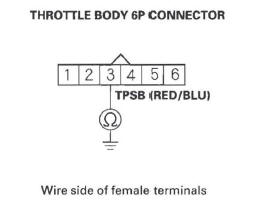
Is there continuity? YES-Repair short in the wire between the throttle body and the PCM (C21), then go to step 18.
NO-Go to step 23.
10. Measure voltage between throttle body 6P connector terminal No.2 and body ground.
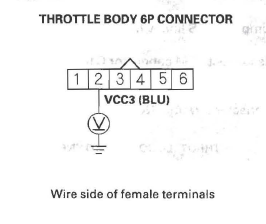
Is there about 5 V?
YES-Go to step 16.
NO-Go to step 11.
11. Turn the ignition switch OFF.
12. Jump the SCS line with the HDS.
13. Disconnect PCM connector C (44P).
14. Disconnect the throttle body 6P connector.
15. Check for continuity between PCM connector terminal C12 and throttle body 6P connector terminal No.2.
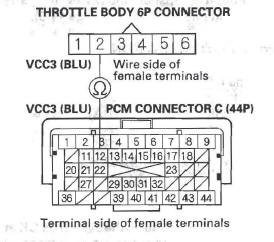
Is there continuity?
YES-Go to step 23.
NO-Repair open in the wire between the throttle body and the PCM (C12), then go to step 18.
16. Turn the ignition switch OFF.
17. Replace the throttle body.
18. Reconnect all connectors.
19. Turn the ignition switch ON (II).
20. Reset the PCM with the HDS.
21. Do the PCM idle learn procedure.
22. Check for Temporary DTCs or DTCs with the HDS.
Is DTC P0222 indicated? YES-Check for poor connections or loose terminals at the throttle body and the PCM, then go to step 1.
NO-Troubleshooting is complete. If any other Temporary DTCs or DTCs are indicated, go to the indicated DTC's troubleshooting.
23. Reconnect all connectors.
24. Update the PCM if it does not have the latest software, or substitute a known-good PCM.
25. Check for Temporary DTCs or DTCs with the HDS.
Is DTC P0222 indicated? YES-Check for poor connections or loose terminals at the throttle body and the PCM. If the PCM was updated, substitute a known-good PCM, then recheck, If the PCM was substituted, go to step 1, NO-If the PCM was updated, troubleshooting is complete. If the PCM was substituted, replace the original PCM. If any other Temporary DTCs or DTCs are indicated, go to the indicated DTC's troubleshooting.
DTC P0223: TP Sensor B Circuit High Voltage
NOTE: Before you troubleshoot, record all freeze data and any on-board snapshot, and review the general troubleshooting information.
1. Turn the ignition switch ON (II).
2. Clear the DTC with the HDS.
3. Check TP SENSOR B in the DATA LIST with the HDS.
Is there about 4.8 V or more? YES-Go to step 4.
NO-Intermittent failure, the system is OK at this time. Check for poor connections or loose terminals at the throttle body and the PCM.
4. Check for Temporary DTCs or DTCs with the HDS.
Are DTC P0123 and P0223 indicated at the same time? YES-Go to step 13.
NO-Go to step 5.
5. Turn the ignition switch OFF.
6. Disconnect the throttle body 6P connector.
7. Turn the ignition switch ON (II).
8. Measure voltage between throttle body 6P connector terminal No.3 and body ground.
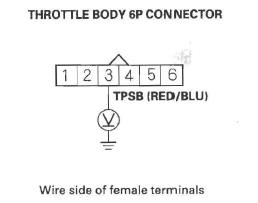
Is there about 5 V? YES-Go to step 18.
NO-Go to step 9.
9. Turn the ignition switch OFF.
10. Jump the SCS line with the HDS.
11. Disconnect PCM connector C (44P).
12. Check for continuity between PCM connector terminal C21 and throttle body 6P connector terminal No.3.
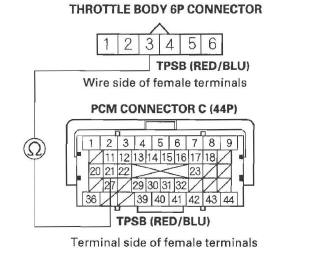
Is there continuity? YES-Go to step 25.
NO-Repair open in the wire between the throttle body and the PCM (C21), then go to step 20.
13. Turn the ignition switch OFF.
14. Disconnect the throttle body 6P connector.
15. Jump the SCS line with the HDS.
16. Disconnect PCM connector C (44P).
17. Check for continuity between PCM connector terminal C39 and throttle body 6P connector terminal No.4.
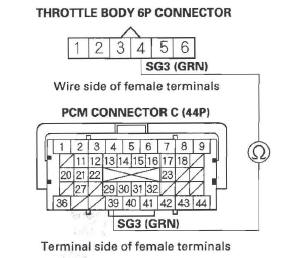
Is there continuity? YES-Go to step 25.
NO-Repair open in the wire between the throttle body and the PCM (C39), then go to step 20.
18. Turn the ignition switch OFF.
19. Replace the throttle body.
20. Reconnect all connectors.
21. Turn the ignition switch ON (II).
22. Reset the PCM with the HDS.
23. Do the PCM idle learn procedure.
24. Check for Temporary DTCs or DTCs with the HDS.
Is DTC P0223 indicated? YES-Check for poor connections or loose terminals at the throttle body and the PCM, then go to step 1.
NO-Troubleshooting is complete. If any other Temporary DTCs or DTCs are indicated, go to the indicated DTC's troubleshooting.
25. Reconnect all connectors.
26. Update the PCM if it does not have the latest software, or substitute a known-good PCM.
27. Check for Temporary DTCs or DTCs with the HDS.
Is DTC P0223 indicated? YES-Check for poor connections or loose terminals at the throttle body and the PCM. If the PCM was updated, substitute a known-good PCM, then recheck. If the PCM was substituted, go to step 1.
NO-If the PCM was updated, troubleshooting is complete. If the PCM was substituted, replace the original PCM. If any other Temporary DTCs or DTCs are indicated, go to the indicated DTC's troubleshooting.

